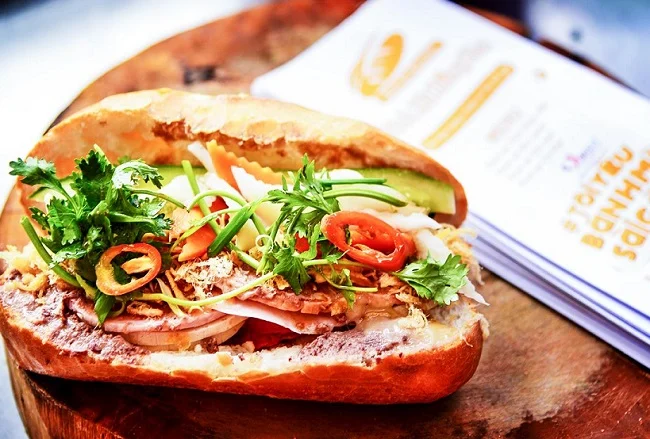HO CHI MINH CITY TRANSFORMS ITS CUISINE INTO “LANGUAGE OF TOURISM”

Promoting the potential and advantages of Vietnam’s largest economic, cultural, and social hub, Ho Chi Minh City has been making efforts to renew its tourism products and diversify events to enrich visitors’ experiences. In particular, its tourism sector is strongly capitalising on local cuisine as a key tourism product to increase the appeal of the city to both domestic and international visitors.
A chef prepares pho at the Landmark81 building, Ho Chi Minh City. (Photo: VNA)
Culinary tourism on the rise
In recent years, the city’s tourism industry has focused on developing diverse products such as river tours, cultural and historical tours, eco-tourism, and community-based tourism. After the administrative unit merger, the sector identified culinary tourism as a key area for growth with the ambition to position HCM City as a hub where Vietnam’s and the world’s specialities converge. This type of tourism is also expected to become a major competitive edge of the city compared to other destinations in Vietnam and regional countries.
Currently, the city has more than 680 tourism resources suitable for development into attractions, with vibrant street food spaces serving as standout features.
Since September 2025, the municipal Department of Tourism has been conducting in-depth surveys to launch 20 new culinary tour programmes. These are not just food journeys but also stories about the city’s culture, history and people.
The Saigontourist Group Culinary Culture, Delicacies Festival held in March 2025. (Photo: VNA)
Upcoming tour packages include two-day-one-night trips such as Flavours of the Sea, A Journey of the Taste Buds, and Returning to Hometown Flavours, as well as shorter half-day and one-day tours like Vespa Le La, Coastal Saigon, a double-decker bus tour with dinner aboard the Indochina Cruise, and the From Farm to Bar organic chocolate farm experience. Travel businesses are also offering self-guided culinary discovery programmes such as Irresistible Flavours of Vung Tau and Unique Cuisine of Binh Duong.
Deputy Director of the Ho Chi Minh City Department of Tourism Bui Thi Ngoc Hieu. (Photo: hcmcpv.org.vn)
Deputy Director of the municipal Department of Tourism Bui Thi Ngoc Hieu said each culinary tour connects dining, shopping, and sightseeing services across the southern metropolis, which now includes former Binh Duong and Ba Ria–Vung Tau provinces. This is part of the city’s culinary tourism development strategy to 2030, and helps attract 10 million international visitors and earn 290 trillion VND (11 billion USD) in tourism revenue this year.
Stalls at the Saigon Street Food Festival held in December 2024. (Photo: VNA)
“With such diverse and culturally rich culinary programmes, HCM City will continue to affirm its position as an international tourism centre and a must-visit destination on the world tourism map,” Hieu said. “We hope these programmes will soon be introduced widely to both domestic and foreign travellers, contributing to a diverse, sustainable, and vibrant tourism ecosystem.”
Ho Chi Minh City looks to attract 10 million international visitors and earn 290 trillion VND (11 billion USD) in tourism revenue this year. (Photo: VNA)
Experts suggest that incorporating local cuisine into tourism offerings is a flexible and progressive approach as Vietnam embraces a new era of development. Culinary tourism has emerged as a significant trend across Asia, especially among Vietnamese travellers, with breakfast options even affecting their choice of accommodations.
Data from Agoda shows that not only Asian but also Vietnamese travellers increasingly prefer hotels offering free breakfast.
Vu Ngoc Lam, Agoda’s Country Director in Vietnam, said: “Breakfast is not just the first meal of the day — it’s a bridge between travellers and local culture. More and more Vietnamese travellers are prioritising booking rooms with breakfast because they understand the practical value and the feeling of being welcomed and cared for that breakfast service brings. Therefore, with smart and easy-to-use search filters, Agoda helps users quickly find ideal accommodations.”
More and more Vietnamese travellers are prioritising booking rooms with breakfast because they understand the practical value and the feeling of being welcomed and cared for that breakfast service brings. (Photo courtesy of Windsor Plaza Hotel)
Spreading Vietnamese flavours to the world
HCM City is not only an attractive destination but also a gateway through which a large number of visitors enter Vietnam. Each of them can be considered a link in spreading Vietnamese flavours to the world. To make local cuisine a “unique language of tourism”, the city aims to create experiences that allow visitors not only to taste but also to feel the soul behind every dish. Director of the Chim Canh Cut Travel Service JSC Tran Quang Duy noted the company is developing food tours to promote the local culinary culture through sustainable and cultural experiences. Each dish tells a story, he said.
Director of the Chim Canh Cut Travel Service JSC Tran Quang Duy. (Photo courtesy of Tran Quang Duy)
Accordingly, each dish introduced to diners is a story, along with the discovery of multi-layered culinary culture from the perspective of “eating to understand and understanding to love”. The enterprise has developed seven typical journeys in line with seven flavours of Saigon – HCM City, namely: Touching the taste of herbs, culinary quintessence, journey of eating authentic food – living healthy, Saigon scent of the past – present, Food Tour in the way of GEN Z, tropical sweetness, Saigon in every corner of Nguyen Thai Binh.
Surveys by local travel firms show that cuisine is a core identity of Ho Chi Minh City’s tourism and a major factor in exploring local culture. Vietravel’s data reveals that 81% of international visitors want to experience local food, proving culinary tourism’s strong global appeal. The city is seen as a “miniature map of Vietnamese cuisine,” with huge potential to build an international brand as “The City of Flavours and Experiences.”
A group of foreign visitors enjoy traditional Vietnamese Tet dishes during the “Westerners Celebrate Vietnamese Tet” tour in Ho Chi Minh City. (Photo: VNA)
Huynh Phan Phuong Hoang, Deputy General Director of Vietravel, proposed that the city issue a culinary tourism development strategy to 2030, create a “HCM City Culinary Destination” recognition system, and establish an international expert centre.
The local tourism industry should strengthen public – private cooperation, organise food events and festivals, design thematic tours, and develop street food associated with the nighttime economy. It should also promote international cooperation and implement marketing campaigns through representative agencies and global businesses, aiming to organise the Southeast Asian Food Festival here in the near future, Hoang said.
Experts also recommend that the city’s tourism and travel companies apply digital transformation to develop online culinary maps, experience videos and interactive content, while training “Culinary Ambassadors” and engaging young people in preserving and innovating traditional cuisine.
They stress that only through collaboration among authorities, associations, enterprises, and creative communities can the city turn its potential into real value, making Vietnamese cuisine a universal language in global tourism and cultural dialogue./.




